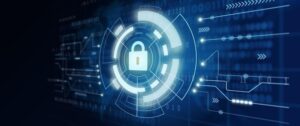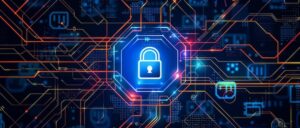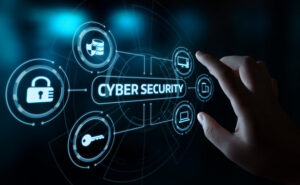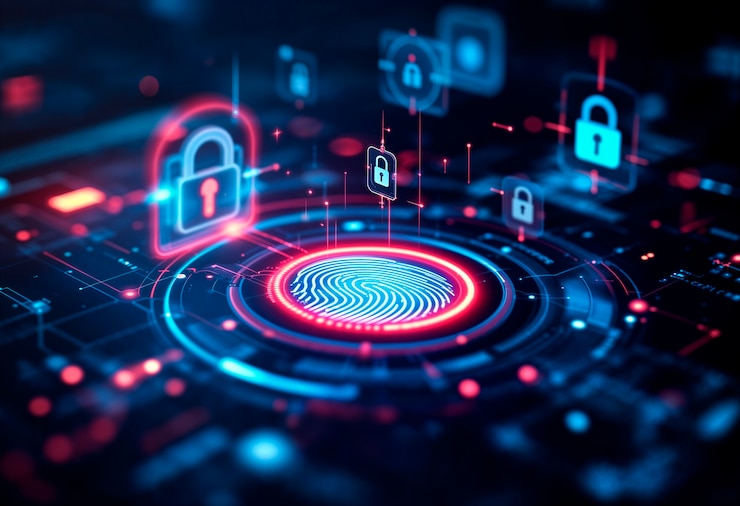Fortifying the Digital Frontier: A Comprehensive Guide to Cybersecurity 2025
The world is becoming increasingly interconnected in which every interaction transactions and even data is often in digital format it is no wonder that the notion is Cybersecurity can be moved from being an IT specialty to becoming a global necessity. From individuals with smartphones to users to large corporations as well as the government protecting digital assets is more important than protecting physical assets.
By mid 2025 level of sophistication and the number of cyber attacks are increasing making an effective Cybersecurity security not only a good option but a crucial requirement for survival and success in this digital era.
This article is a deep dive deep into the vast realm that is Cybersecurity and will explore its basic definitions the ever changing nature of security threats the key crucial pillars that it rests on as well as the common attack vectors that are important best practices.
that are applicable to both organisations and individuals as well as the significance in ensuring compliance to regulations as well as an insight into the future developments that will shape this crucial field. Knowing Cybersecurity will be not a luxury anymore; it is crucial to navigate the world of today safely and safely. Also check us A Brief History of Consumer Electronics

What Exactly is Cybersecurity?
Cybersecurity is the act of protecting computers networks and information from cyber attack destruction or unauthorised access. The primary objective is to protect the security as well as the integrity and accessibility (CIA three point security) of data.
- Privacy: Ensuring that sensitive data is only accessible by authorized users. It involves security measures encryption as well as strict security measures.
- Integrity Conserving the integrity and accuracy of data. It is the process of securing information from accidental deletion or modification as well as ensuring the integrity of data.
- accessibility: Guaranteeing that authorized users are able to access the system as well as data at times when it is needed. This includes defending against denial of service attacks as well as ensuring that the system is up and running by ensuring redundancy and a robust infrastructure.
It is in essence Cybersecurity can be described as the collection of guidelines instruments security measures guidelines and risk management strategies activities education and tools used to safeguard digital assets. It’s a continuous evolving procedure of safeguarding against changing security threats.
The Evolving Threat Landscape in Cybersecurity
The nature of cyber-attacks changes constantly and is driven by the advancement of technology along with geopolitical tensions as well as the ingenuity and creativity of malicious actors. The security strategy only a few years ago may not be sufficient now.
The field is one of Cybersecurity has evolved into a very complex arena with adversaries that are typically very well funded and organized and quick to exploit any new security holes. Cyberattacks in the past may be the product by isolated hackers. However now were facing advanced security threats coming from
- Organised Cybercrime Syndicates: Driven by the desire for financial profit the groups carry out large scale ransomware campaigns phishing attacks as well as data breach.
- Nation State actors: engaged in espionage disruption of critical infrastructure and intellectual property theft. Usually having significant resources as well as advanced persistent threat (APTs).
- Hacktivists groups that use cyber attacks in order to advance a Social or political agenda.
- Insider Threats Unhappy employees or those forced by outside actors could cause serious damage inside an organisation.
The increased interconnectivity brought on through internet of things (IoT) Internet of Things (IoT) cloud computing ubiquitous mobile devices has increased the scope of attack. The complex nature of the cyberspace requires an adaptive proactive and comprehensive strategy for Cybersecurity.
![]()
Common Cybersecurity Threats
Knowing the most common attack methods is crucial to establishing an effective Cybersecurity protections. Below are the most common security threats:
- malware: An umbrella term used to describe malicious software that is intended to harm disable or gain unauthorized access PC systems. This includes:
- Viral infections: Connect them to legitimate software and then spread once those software is executed.
- Worms self replicating and spreading programs over networks with no human intervention.
- Trojan Horses: Malicious programs disguised as legitimate software.
- Spyware In secret it monitors user activities and gathers private data.
- Adware Shows ads that are not needed.
- Phishing A method of social engineering that allows attackers to impersonate a trusted organization (e.g. an institution bank well known business or a federal agency) to get people giving out sensitive information such as passwords usernames as well as credit card information and to install malware. Spear phishing is targeted towards specific users as well as high profile executive. Affordable Cybersecurity education includes the ability to recognize phishing attacks.
- ransomware The type of virus that blocks the victims data and asks for an amount of ransom (often in crypto) to obtain the key to decrypt. If the ransom isnt paid the information could be lost for ever or compromised. It is now among the top costly kinds of cyberattack. A solid backup strategy and a robust recovery plan are crucial for ensuring Ransomware Cybersecurity.
- DDoS (DoS) as well as Distributed DoS and Distributed (DDoS) attacks: These attacks aim to render a website or service site unusable by flooding the site with an avalanche of traffic coming from a single or multiple sources (DoS) as well as multiple compromised devices (DDoS). It prevents legitimate users from accessing the website. The protection of Web infrastructure is an essential component of Cybersecurity.
- Social engineering: Tricking people into doing something or sharing confidential data. It includes phishing however it also includes pretexting (creating fake scenarios for a target to be enticed) and baiting (luring users with attractive offer) as well as quid pro or quid pro (promising an advantage in exchange for data). The human factor remains the weakest component within Cybersecurity.
- Zero Day Exploits weaknesses on hardware or software that arent known by either the manufacturer or public. This means that theres no update available. Hackers take advantage of the “zero day” weaknesses before developers are able to correct the issue making them very risky and difficult to protect against.
- Man in the Middle (MitM) Threats: Attackers intercept communication between two people usually with no knowledge of the other party they are listening or stealing data or alter the messages. The attack can take place over weak Wi Fi networks as well as through vulnerable web servers.
- SQL Injection An online security flaw which allows hackers to alter the queries the application sends in its database. The attackers can see modify or delete sensitive data or gain access to administrative control of the database. Applications Cybersecurity can be a key element in this regard.
Key Pillars and Domains of Cybersecurity
Affordable Cybersecurity doesnt require one solution that is multi layered integrated strategy covering diverse domains
- Network Security protecting computer networks against intruders. This includes firewalls intrusion detection systems (IDS/IPS) and VPNs (VPNs) as well as network segmentation. This is the initial security layer when it comes to Cybersecurity.
- App Security Protecting devices software and other applications from attacks throughout the entire lifespan. This includes secure code techniques regularly testing for vulnerabilities (e.g. penetration testing static and dynamic application security testing SAST/DAST) as well as API security.
- Data security: Security of data both at the moment of rest during transit as well as when it is in the course of. This includes encryption as well as the prevention of data loss (DLP) tools as well as access control techniques for data backup and recovery. Data is the primary attack target for many cyber attacks and data breaches which is why Cybersecurity essential.
- Endpoint Security Secure devices for end users including laptops desktops as well as tablets smartphones and desktops. It includes anti virus software Endpoint detection and response (EDR) solution as well as devices management guidelines.
- Cloud Security Protection of applications data and the infrastructure that is involved with cloud computing. This is a shared obligation for both the cloud provider as well as the user and covers the areas of cloud based access security brokers (CASB) cloud platforms for workload protection (CWPP) as well as identification management. Since organizations are moving towards cloud based computing and cloud computing cloud Cybersecurity is becoming ever more essential.
- ID and Access Management (IAM): Managing and controlling who (or who) is able to access which resources and under what situations. This can include the use of strong authentication (e.g. multi factor authentication also known as MFA) as well as Single sign on (SSO) as well as roles based access controls (RBAC). Secure IAM is the foundation of every Cybersecurity system.
- Incident response: The method of planning to manage and handle the consequences of a security incident or cyberattack. It involves the detection of the breach its investigation control elimination of the threat recovery and post incident examination. A well designed incident response plan is essential to an active Cybersecurity.
- Awareness and Education of Users: Training employees and users on Cybersecurity the best methods and recognizing potential the signs of a threat (like the phishing) and knowing their roles in keeping security. Humans are often the weakest link. This makes constant education an integral part of successful Cybersecurity.
Essential Cybersecurity Best Practices

An approach that is layered which combines process technology and individuals is essential to ensuring Cybersecurity.
For Individuals:
- Utilize unique strong passwords: Create long complicated passwords by mixing of lower and upper case numerals letters and other symbols. Never reuse passwords across different accounts. Make use of a password manager in order for secure storage and generation of complicated passwords.
- Allow Multi Factor Authentication (MFA): Whenever it is possible you should enable MFA as often as you can (also called two factor authentication or 2FA). This provides an additional security layer by needing a different type of proof (e.g. the number from your mobile or a fingerprint) along with your password. Its an easy but extremely effective Cybersecurity method.
- Keep your software up to date: Regularly update your operating system browsers anti virus software and every other application. Updates usually include important security patches to solve known weaknesses.
- Beware of suspicious Link and Attachments Take extreme care when receiving unwelcome emails messages or pop ups. Beware of clicking on links that appear suspicious or download attachments sent by unknown recipients. Verify the identity of the sender when youre not sure. Phishing is a major danger vector. This makes being vigilant vital for security of your personal Cybersecurity.
- Use secure Wi Fi Do not conduct sensitive transactions (online banking and shopping) in public non secure Wi Fi networks.
- Save Your Data Make sure you regularly back up your important files to a external hard drive or safe cloud service. Your data is protected from the threat of ransomware accidental deletion or hardware malfunction. A solid backup strategy is an essential component of security for your personal Cybersecurity.
For Organizations:
- Install a Layered Defence (Defence in depth): No single solution can provide complete security. Mix various Cybersecurity security controls such as firewalls antivirus IDS/IPS EDR Data encryption as well as access control.
- Conduct regular security audits and testing for penetration: Periodically assess your network and systems for weaknesses. Testing for penetration simulates attacks in real life to find weak points.
- invest in employee Cybersecurity Education: Regular engaging education programs are essential for educating employees on the most common security threats such as phishing social engineering as well as the best practices in handling data. They are the most vulnerable connection in the Cybersecurity chain.
- Make and test an Incident Response Plan Develop a well defined written plan of what you will accomplish prior during as well as after an attack. Conduct regular drills to make sure your team members know their responsibilities. Quick response is a great way to minimize any damage.
- Create a robust backup of data and Recovery Regular off site and mutable backups are essential to recover from ransomware attack as well as natural disasters or accidentally lost data. This is the most fundamental component of the organizations Cybersecurity.
- Use security Frameworks as well as Standards: Adopting frameworks such as NIST Cybersecurity Framework ISO 27001 and CIS Controls offers a standardized method of managing and enhancing your security measures for your business.
- Secure Access Controls and the smallest Access Rights: Grant users only the access rights they require to fulfill their duties. Review and remove any unnecessary access.
- Patch Management Create a thorough procedure to apply security patches and update to every system and program promptly.
- Supply Chain Security Be aware that your companys Cybersecurity will only become as secure as its weakest point and thats usually the third party vendors and suppliers. Review suppliers thoroughly and set up safe contract.
The Role of Regulations and Compliance in Cybersecurity
To combat the growing incidence and frequency of cyber-attacks government and business bodies around the world have enacted stricter laws aimed at protecting personal information and guaranteeing transparency. The compliance with these rules doesn’t just mean that you avoid fines; it’s about creating confidence and showing a commitment to a robust Cybersecurity.
HIPAA (Health insurance portability and accountability act): A US law that defines guidelines for the protection of sensitive patient health data.
- PCI DSS (Payment Card Industry Data Security Standard): An international standard created to make sure that all businesses which process store or send credit card information keep their information secured environment.
- The Indian IT Act (Information Technology Act 2000 and amendments): Provides the legal basis to regulate electronic transactions and regulates cybercriminals in India.
- DPDP Act (Digital Personal Data Protection Act 2023 India): Indias most recent legislation on data protection which mirrors aspects of GDPR. It focuses on the use of personal information in digital form.
Compliance with these rules typically requires the use of certain Cybersecurity control measures such as audit trails encryption of data as well as transparent methods of handling data. In the absence of these regulations you could face massive fines damage to reputation and loss of confidence.
Emerging Trends and the Future of Cybersecurity

The area that is Cybersecurity has been currently in an ever changing state fueled by both technological developments and the constantly changing threats from the players.
- AI as well as Machine Learning in Cybersecurity: AI and Machine Learning are becoming increasingly utilized for analyzing huge quantities of data identify suspicious patterns anticipate the threat automatically respond and improve the threat intelligence. These technologies are changing how we think about Cybersecurity.
- Quantum Computing and Cryptography: While still nascent quantum computing could pose an ongoing threat to the current encryption protocols. Studies into post quantum cryptography are This will help protect future Cybersecurity.
- Zero Trust Architecture: In a departure from the old “trust but verify” model Zero Trust operates on the principal of “never trust always verify. This paradigm shift is a boost to Cybersecurity.
- Supply Chain Security Cyberattacks are increasingly targeting security holes in the software supply chain (e.g. SolarWinds Log4j etc.). The focus of organizations is on screening third party software components and service suppliers. It is an ever-growing sector in Cybersecurity.
- Human Centric Security Realizing that technology alone won’t suffice Theres an increasing emphasis on understanding human behaviour and developing security strategies that enable users to make informed decisions instead of hindering their choices.
- Cyber Resilience Beyond the mere protection companies is now looking to rapidly recover from cyber related incidents and ensure critical functions continue even in the event of cyber threats. It requires robust plan of backups crisis responses and continuity planning. This makes resilience a crucial metric to measure Cybersecurity.
Cybersecurity has become no longer just the responsibility of IT departments it is a shared responsibility that extends to each individual company and even the nations. The cyberspace frontier is always growing and along this is accompanied by the complexity and scope of cyber-attacks.
From ransomware-based gangs that hold crucial data hostage to state agents engaged in sophisticated spying The need for sound flexible proactive and adaptive Cybersecurity security measures has never been more crucial.
In gaining a better understanding of the core rules of confidentiality integrity and availability as well as identifying the most common attacks adopting multi layered best practices as well as keeping abreast of new developments we are able to collectively enhance our defenses against cyberattacks.
The war to ensure Cybersecurity can be an ongoing race not one that is a race. Constant vigilance training and investment in the latest technology and a united dedication to protecting our digital lives are essential to living safely in this digital age
